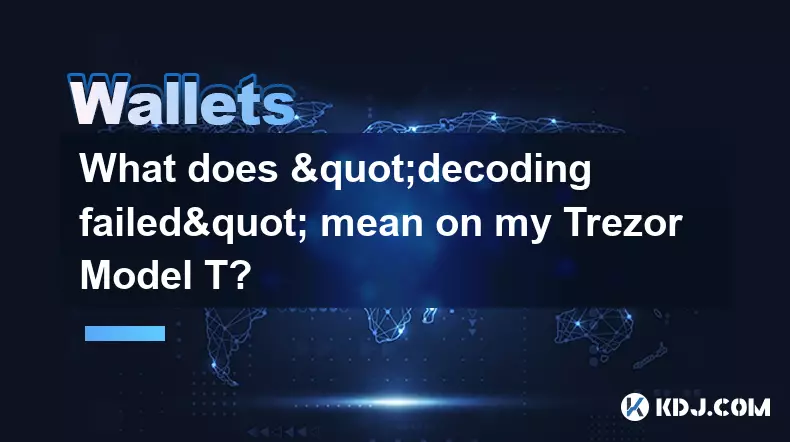-
 bitcoin
bitcoin $108221.513755 USD
-0.10% -
 ethereum
ethereum $3817.049350 USD
-1.16% -
 tether
tether $1.000184 USD
-0.03% -
 bnb
bnb $1081.373706 USD
1.55% -
 xrp
xrp $2.367284 USD
-2.30% -
 solana
solana $180.847708 USD
-3.07% -
 usd-coin
usd-coin $0.999936 USD
0.00% -
 tron
tron $0.322230 USD
-0.06% -
 dogecoin
dogecoin $0.190590 USD
-1.92% -
 cardano
cardano $0.626657 USD
-2.42% -
 hyperliquid
hyperliquid $37.280123 USD
6.15% -
 chainlink
chainlink $17.222315 USD
-2.46% -
 ethena-usde
ethena-usde $0.999312 USD
-0.03% -
 stellar
stellar $0.309699 USD
-0.98% -
 bitcoin-cash
bitcoin-cash $475.445788 USD
-1.02%
Can I use two Trezor Model T devices as backups for each other?
The Trezor Model T enhances crypto security by storing private keys offline, but two devices can't back each other up—each has a unique, isolated seed.
Oct 23, 2025 at 09:20 am

Understanding the Role of Trezor Model T in Cryptocurrency Security
1. The Trezor Model T is a hardware wallet designed to store cryptocurrency private keys offline, providing a high level of security against online threats such as hacking and phishing. It supports a wide range of digital assets and integrates with various wallet interfaces like Trezor Suite and third-party platforms.
2. Each Trezor device generates a unique seed phrase during setup, typically consisting of 12, 18, or 24 words. This seed is the foundation of all private keys associated with the wallet and must be stored securely. Losing the seed phrase means losing access to funds, even if the device remains intact.
3. While the Trezor Model T features a touchscreen and advanced interface compared to earlier models, its core functionality revolves around secure key management and transaction signing. It does not function as a traditional backup device for another hardware wallet.
4. Users often assume that pairing two identical devices enhances redundancy. However, each Trezor operates independently, meaning their seed phrases are not synchronized or linked in any way. One cannot restore the other using standard recovery procedures unless the same seed is manually imported—which introduces security risks.
Why Two Trezor Devices Cannot Serve as Direct Backups
1. Hardware wallets like the Trezor Model T are built on the principle of isolation. Each unit creates a separate cryptographic environment. Even if both devices are initialized at different times, they will produce entirely distinct seed phrases and corresponding private keys.
2. To make one Trezor mirror another, you would need to input the original seed phrase into the second device. Doing so violates best security practices because exposing the seed phrase—even to another trusted device—increases the risk of compromise. Seed phrases should never be typed into software environments or transferred between devices.
3. Trezor firmware does not support automatic synchronization of seeds or keys across multiple units. There is no built-in feature allowing two Model T devices to act as live mirrors or failover systems for each other.
4. If the goal is redundancy, the recommended method is to write down the seed phrase from the primary device and store it securely in multiple physical locations. Using a second Trezor to hold an exact copy of this seed undermines the purpose of air-gapped security.
Secure Alternatives for Redundancy and Recovery
1. Instead of relying on a second Trezor Model T as a backup, users should focus on securing the original seed phrase. Options include engraving the seed onto metal plates resistant to fire and water, or using specialized backup solutions like Cryptotag or Billfodl.
2. Some advanced users employ Shamir Backup (SLIP-39), available on the Trezor Model T, which splits the seed into multiple shares. A predefined number of shares can reconstruct the original seed, enabling distributed storage without requiring a full copy in one place.
3. Storing paper or metal backups in geographically separated secure locations—such as a home safe and a safety deposit box—provides better protection than duplicating the seed onto another electronic device.
4. Regularly verifying the recovery process by restoring the wallet on a secondary device (then wiping it) ensures that the backup works without permanently exposing the seed. This test should be done carefully and never on a device connected to the internet unnecessarily.
Frequently Asked Questions
Can I transfer my cryptocurrency balance by connecting two Trezor Model T wallets?No, transferring funds requires initiating transactions through wallet software using the active device. You cannot directly sync balances or keys between two Trezors. Funds must be sent from one wallet to the receiving address of the other, just like with any independent crypto accounts.
Is it safe to store my seed phrase on a second Trezor Model T?It is not recommended. Entering your seed phrase into any device, including another Trezor, exposes it to potential malware or interception during input. The safest approach is offline, non-digital storage methods that avoid electronic entry altogether.
What happens if I lose one of my two Trezor devices?If each device has a different seed, losing one means losing access to the funds stored on it unless you have its backup. Owning two devices doesn’t inherently protect against loss unless proper backup procedures were followed for each individual unit.
Does Trezor support multi-signature setups for added redundancy?Yes, Trezor integrates with multisig wallet services like Specter Desktop and Casa. These allow multiple devices (even different brands) to participate in a shared wallet where transactions require approval from a defined number of signers, enhancing both security and fault tolerance.
Disclaimer:info@kdj.com
The information provided is not trading advice. kdj.com does not assume any responsibility for any investments made based on the information provided in this article. Cryptocurrencies are highly volatile and it is highly recommended that you invest with caution after thorough research!
If you believe that the content used on this website infringes your copyright, please contact us immediately (info@kdj.com) and we will delete it promptly.
- Essex Post Office, 5p Coins, and King Charles: A Royal Mint Revelation!
- 2025-10-23 10:30:16
- Waymo's Newark Airport AV Tests: Alphabet's AI Gamble Pays Off?
- 2025-10-23 10:30:16
- King Charles 5p Coins: A Royal Flush in Your Pocket?
- 2025-10-23 10:35:18
- Solana, Crypto Advisory, and Forward Industries: A New York Minute on the Future of Finance
- 2025-10-23 08:51:22
- MAGACOIN: Ethereum Whales Dive into the Hottest Presale of 2025
- 2025-10-23 08:51:22
- Kadena's End of the Road? KDA Token Plummets Amid Project Abandonment
- 2025-10-23 08:55:34
Related knowledge

Can I recover a Trezor Model T wallet using a 12-word seed?
Oct 22,2025 at 12:37am
Understanding Trezor Model T and Seed Phrase Compatibility1. The Trezor Model T supports BIP39-based 12-word recovery seed phrases, allowing users to ...

What does "decoding failed" mean on my Trezor Model T?
Oct 21,2025 at 04:00am
Understanding 'Decoding Failed' on Trezor Model T1. The error message 'decoding failed' on a Trezor Model T typically appears during transaction signi...

Can I use two Trezor Model T devices as backups for each other?
Oct 23,2025 at 09:20am
Understanding the Role of Trezor Model T in Cryptocurrency Security1. The Trezor Model T is a hardware wallet designed to store cryptocurrency private...

Why is MetaMask not finding my Trezor Model T?
Oct 22,2025 at 05:00am
Understanding Wallet Connectivity Between MetaMask and Hardware Devices1. MetaMask is a software-based Ethereum wallet that supports integration with ...

Is the Trezor Model T waterproof?
Oct 23,2025 at 12:54am
Understanding the Trezor Model T and Environmental Resistance1. The Trezor Model T is a popular hardware wallet designed to securely store cryptocurre...

How to set up a new wallet on an existing Trezor Model T?
Oct 20,2025 at 12:36am
Initializing a New Wallet on Your Trezor Model T1. Connect your Trezor Model T to your computer using the provided USB cable. Ensure that the device i...

Can I recover a Trezor Model T wallet using a 12-word seed?
Oct 22,2025 at 12:37am
Understanding Trezor Model T and Seed Phrase Compatibility1. The Trezor Model T supports BIP39-based 12-word recovery seed phrases, allowing users to ...

What does "decoding failed" mean on my Trezor Model T?
Oct 21,2025 at 04:00am
Understanding 'Decoding Failed' on Trezor Model T1. The error message 'decoding failed' on a Trezor Model T typically appears during transaction signi...

Can I use two Trezor Model T devices as backups for each other?
Oct 23,2025 at 09:20am
Understanding the Role of Trezor Model T in Cryptocurrency Security1. The Trezor Model T is a hardware wallet designed to store cryptocurrency private...

Why is MetaMask not finding my Trezor Model T?
Oct 22,2025 at 05:00am
Understanding Wallet Connectivity Between MetaMask and Hardware Devices1. MetaMask is a software-based Ethereum wallet that supports integration with ...

Is the Trezor Model T waterproof?
Oct 23,2025 at 12:54am
Understanding the Trezor Model T and Environmental Resistance1. The Trezor Model T is a popular hardware wallet designed to securely store cryptocurre...

How to set up a new wallet on an existing Trezor Model T?
Oct 20,2025 at 12:36am
Initializing a New Wallet on Your Trezor Model T1. Connect your Trezor Model T to your computer using the provided USB cable. Ensure that the device i...
See all articles










































































